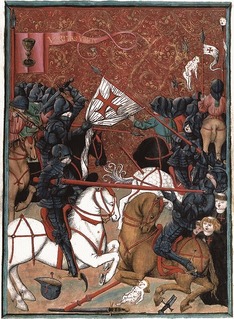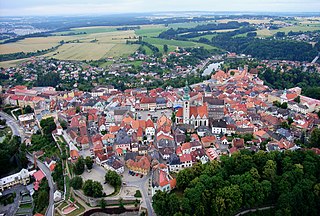
Bohemia is the westernmost and largest historical region of the Czech lands in the present-day Czech Republic. Bohemia can also refer to a wider area consisting of the historical Lands of the Bohemian Crown ruled by the Bohemian kings, including Moravia and Czech Silesia, in which case the smaller region is referred to as Bohemia proper as a means of distinction.

The Czech Republic, also known as Czechia is a landlocked country in Central Europe. It is bordered by Austria to the south, Germany to the west, Poland to the northeast, and Slovakia to the southeast. The Czech Republic has a hilly landscape that covers an area of 78,871 square kilometers (30,452 sq mi) with a mostly temperate continental and oceanic climate. The capital and largest city is Prague, and other major cities include Brno and Ostrava.
Czech, historically also Bohemian, is a West Slavic language of the Czech–Slovak group, written in Latin script. Spoken by over 10 million people, it serves as the official language of the Czech Republic. Czech is closely related to Slovak, to the point of high mutual intelligibility, as well as to Polish to a lesser degree. Czech is a fusional language with a rich system of morphology and relatively flexible word order. Its vocabulary has been extensively influenced by Latin and German.

The Hussites were a Czech Proto-Protestant Christian movement that followed the teachings of reformer Jan Hus, who became the best known representative of the Bohemian Reformation.

Jan Hus, sometimes anglicized as John Hus or John Huss, and referred to in historical texts as Iohannes Hus or Johannes Huss, was a Czech theologian and philosopher who became a Church reformer and the inspiration of Hussitism, a key predecessor to Protestantism, and a seminal figure in the Bohemian Reformation. Hus is considered by some to be the first Church reformer, even though some designate this honour to the theorist John Wycliffe or Marcion of Sinope. His teachings had a strong influence, most immediately in the approval of a reformed Bohemian religious denomination and, over a century later, on Martin Luther. Hus was a master, dean, and rector at the Charles University in Prague 1409-1410.

The Slavic languages, also known as the Slavonic languages, are Indo-European languages spoken primarily by the Slavic peoples or their descendants. They are thought to descend from a proto-language called Proto-Slavic, spoken during the Early Middle Ages, which in turn is thought to have descended from the earlier Proto-Balto-Slavic language, linking the Slavic languages to the Baltic languages in a Balto-Slavic group within the Indo-European family.

Z, or z, is the twenty-sixth and final letter of the modern English alphabet and the ISO basic Latin alphabet. Its usual names in English are zed and zee, with an occasional archaic variant izzard.

The Czechs, or the Czech people, are a West Slavic ethnic group and a nation native to the Czech Republic in Central Europe, who share a common ancestry, culture, history, and the Czech language.
A caron, háček or haček also known as a hachek, wedge, check, kvačica, strešica, mäkčeň, paukščiukas, inverted circumflex, inverted hat, flying bird, inverted chevron, is a diacritic (◌̌) commonly placed over certain letters in the orthography of some languages to indicate a change in the related letter's pronunciation.

Tábor is a town in the South Bohemian Region of the Czech Republic. It has about 34,000 inhabitants. The town centre is well preserved and is protected by law as an urban monument reservation.

Jan Žižka z Trocnova a Kalicha was a Czech general – a contemporary and follower of Jan Hus and a Radical Hussite who led the Taborites. Žižka was a successful military leader and is now a Czech national hero. He was nicknamed "One-eyed Žižka", having lost one and then both eyes in battle. Jan Žižka led Hussite forces against three crusades and never lost a single battle despite being completely blind in his last stages of life.

The Hussite Wars, also called the Bohemian Wars or the Hussite Revolution, were a series of wars fought between the Hussites and the combined Catholic forces of Holy Roman Emperor Sigismund, the Papacy, European monarchs loyal to the Catholic Church, as well as various Hussite factions. At a late stage of the conflict, the Utraquists changed sides in 1432 to fight alongside Roman Catholics and opposed the Taborites and other Hussite spinoffs. These wars lasted from 1419 to approximately 1434.
The first Slovak orthography was proposed by Anton Bernolák (1762–1813) in his Dissertatio philologico-critica de litteris Slavorum, used in the six-volume Slovak-Czech-Latin-German-Hungarian Dictionary (1825–1927) and used primarily by Slovak Catholics.
Some English language terms have letters with diacritical marks. Most of the words are loanwords from French, with others coming from Spanish, Portuguese, German, or other languages. The diaeresis mark, the grave accent and the acute accent are the only diacritics native to Modern English, but their usage is considered to be largely archaic.

The Kingdom of Bohemia, sometimes later in English literature referred to as the Czech Kingdom, was a medieval and early modern monarchy in Central Europe, the predecessor of the modern Czech Republic. It was an Imperial State in the Holy Roman Empire, and the Bohemian king was a prince-elector of the empire. The kings of Bohemia, besides the region of Bohemia proper itself, also ruled other lands belonging to the Bohemian Crown, which at various times included Moravia, Silesia, Lusatia, and parts of Saxony, Brandenburg, and Bavaria.
Czech orthography is a system of rules for correct writing (orthography) in Czech.

The Latin script is the most widely used alphabetic writing system in the world. It is the standard script of the English language and is often referred to simply as "the alphabet" in English. It is a true alphabet which originated in the 7th century BC in Italy and has changed continually over the last 2,500 years. It has roots in the Semitic alphabet and its offshoot alphabets, the Phoenician, Greek, and Etruscan. The phonetic values of some letters changed, some letters were lost and gained, and several writing styles ("hands") developed. Two such styles, the minuscule and majuscule hands, were combined into one script with alternate forms for the lower and upper case letters. Due to classicism, modern uppercase letters differ only slightly from their classical counterparts. There are few regional variants.

A wagon fort, wagon fortress, or corral, often referred to as circling the wagons, is a temporary fortification made of wagons arranged into a rectangle, circle, or other shape and possibly joined with each other to produce an improvised military camp. It is also known as a laager, especially in historical African contexts, and a tabor among the Cossacks.

Religion in the Czech Republic is varied, with a vast majority of the population (78%) being either irreligious or declaring neither religious nor irreligious identities, and almost equal minorities represented by Christianity and other religious identities or beliefs (10.8%). The religious identity of the country has changed drastically since the first half of the 20th century, when more than 90% of the Czechs were Christians. According to the sociologist Jan Spousta, not all the irreligious or neither religiously nor irreligiously identified people are atheists; indeed, since the late 20th century there has been an increasing distancing from both Christian dogmatism and atheism, and at the same time ideas and non-institutional models similar to those of Eastern religions have become widespread through movements started by various gurus, and hermetic and mystical paths.

Slavicisms or Slavisms are words and expressions borrowed or derived from Slavic languages.













